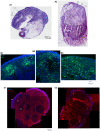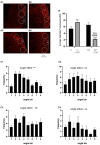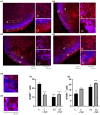Immune Factor, TNFα, Disrupts Human Brain Organoid Development Similar to Schizophrenia-Schizophrenia Increases Developmental Vulnerability to TNFα
- PMID: 33005129
- PMCID: PMC7484483
- DOI: 10.3389/fncel.2020.00233
Immune Factor, TNFα, Disrupts Human Brain Organoid Development Similar to Schizophrenia-Schizophrenia Increases Developmental Vulnerability to TNFα
Abstract
Schizophrenia (SZ) is a neurodevelopmental genetic disorder in which maternal immune activation (MIA) and increased tumor necrosis factor-α (TNF-α) may contribute. Previous studies using iPSC-derived cerebral organoids and neuronal cells demonstrated developmental malformation and transcriptional dysregulations, including TNF receptors and their signaling genes, common to SZ patients with diverse genetic backgrounds. In the present study, we examined the significance of the common TNF receptor dysregulations by transiently exposing cerebral organoids from embryonic stem cells (ESC) and from representative control and SZ patient iPSCs to TNF. In control iPSC organoids, TNF produced malformations qualitatively similar in, but generally less pronounced than, the malformations of the SZ iPSC-derived organoids. TNF and SZ alone disrupted subcortical rosettes and dispersed proliferating Ki67+ neural progenitor cells (NPC) from the organoid ventricular zone (VZ) into the cortical zone (CZ). In the CZ, the absence of large ramified pan-Neu+ neurons coincided with loss of myelinated neurites despite increased cortical accumulation of O4+ oligodendrocytes. The number of calretinin+ interneurons increased; however, they lacked the preferential parallel orientation to the organoid surface. SZ and SZ+TNF affected fine cortical and subcortical organoid structure by replacing cells with extracellular matrix (ECM)-like fibers The SZ condition increased developmental vulnerability to TNF, leading to more pronounced changes in NPC, pan-Neu+ neurons, and interneurons. Both SZ- and TNF-induced malformations were associated with the loss of nuclear (n)FGFR1 form in the CZ and its upregulation in deep IZ regions, while in earlier studies blocking nFGFR1 reproduced cortical malformations observed in SZ. Computational analysis of ChiPseq and RNAseq datasets shows that nFGFR1 directly targets neurogenic, oligodendrogenic, cell migration, and ECM genes, and that the FGFR1-targeted TNF receptor and signaling genes are overexpressed in SZ NPC. Through these changes, the developing brain with the inherited SZ genome dysregulation may suffer increased vulnerability to TNF and thus, MIA.
Keywords: neural progenitor cell; nuclear fibroblast growth factor receptor-1; oligodendrocyte; organoids; schizophrenia; tumor necrosis factor.
Copyright © 2020 Benson, Powell, Liput, Dinham, Freedman, Ignatowski, Stachowiak and Stachowiak.
Figures







Similar articles
-
Cerebral organoids reveal early cortical maldevelopment in schizophrenia-computational anatomy and genomics, role of FGFR1.Transl Psychiatry. 2017 Nov 17;7(11):6. doi: 10.1038/s41398-017-0054-x. Transl Psychiatry. 2017. PMID: 30446636 Free PMC article.
-
Common developmental genome deprogramming in schizophrenia - Role of Integrative Nuclear FGFR1 Signaling (INFS).Schizophr Res. 2017 Jul;185:17-32. doi: 10.1016/j.schres.2016.12.012. Epub 2017 Jan 13. Schizophr Res. 2017. PMID: 28094170 Free PMC article.
-
Attenuated transcriptional response to pro-inflammatory cytokines in schizophrenia hiPSC-derived neural progenitor cells.Brain Behav Immun. 2022 Oct;105:82-97. doi: 10.1016/j.bbi.2022.06.010. Epub 2022 Jun 16. Brain Behav Immun. 2022. PMID: 35716830 Free PMC article.
-
Neurodevelopmental disturbances in schizophrenia: evidence from genetic and environmental factors.J Neural Transm (Vienna). 2023 Mar;130(3):195-205. doi: 10.1007/s00702-022-02567-5. Epub 2022 Nov 12. J Neural Transm (Vienna). 2023. PMID: 36370183 Free PMC article. Review.
-
Challenges in Modeling Human Neural Circuit Formation via Brain Organoid Technology.Front Cell Neurosci. 2020 Dec 3;14:607399. doi: 10.3389/fncel.2020.607399. eCollection 2020. Front Cell Neurosci. 2020. PMID: 33362473 Free PMC article. Review.
Cited by
-
Brain-printing biometrics underlying mechanism as an early diagnostic technique for Alzheimer's disease neurodegenerative type.Curr Res Physiol. 2021 Oct 2;4:216-222. doi: 10.1016/j.crphys.2021.09.005. eCollection 2021. Curr Res Physiol. 2021. PMID: 34746841 Free PMC article. Review.
-
Human-Induced Pluripotent Stem Cell Technology: Toward the Future of Personalized Psychiatry.J Pers Med. 2022 Aug 20;12(8):1340. doi: 10.3390/jpm12081340. J Pers Med. 2022. PMID: 36013289 Free PMC article. Review.
-
Leveraging iPSC technology to assess neuro-immune interactions in neurological and psychiatric disorders.Front Psychiatry. 2023 Nov 9;14:1291115. doi: 10.3389/fpsyt.2023.1291115. eCollection 2023. Front Psychiatry. 2023. PMID: 38025464 Free PMC article. Review.
-
Peering into the mind: unraveling schizophrenia's secrets using models.Mol Psychiatry. 2025 Feb;30(2):659-678. doi: 10.1038/s41380-024-02728-w. Epub 2024 Sep 8. Mol Psychiatry. 2025. PMID: 39245692 Review.
-
Current advancements of modelling schizophrenia using patient-derived induced pluripotent stem cells.Acta Neuropathol Commun. 2022 Dec 16;10(1):183. doi: 10.1186/s40478-022-01460-2. Acta Neuropathol Commun. 2022. PMID: 36527106 Free PMC article. Review.
References
-
- Ajami A., Abedian F., Hamzeh Hosseini S., Akbarian E., Alizadeh-Navaei R., Taghipour M. (2014). Serum TNF-α, IL-10 and IL-2 in schizophrenic patients before and after treatment with risperidone and clozapine. Iran. J. Immunol. 11, 200–209. - PubMed
LinkOut - more resources
Full Text Sources
Research Materials
Miscellaneous

